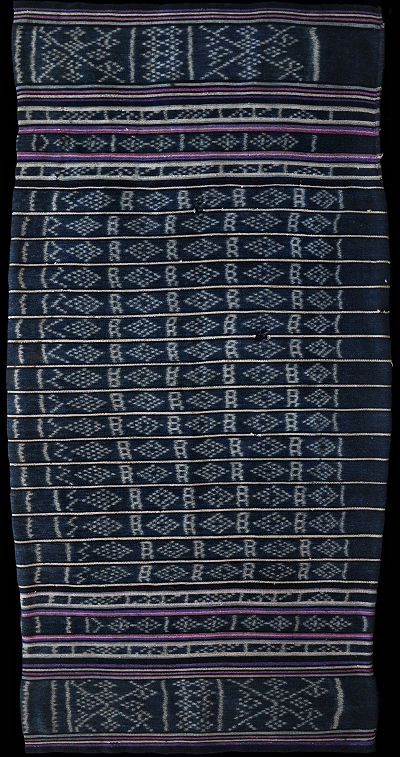| |
209 Flores Group, Palu'e
Tama (sarong)  
|
| Locale: | Palue (off Flores), probably. Caveat: origin not beyond doubt due to absence of true cognates with certified provenance. |
| Period: | 19th c. to very early 20th c. |
| Yarn: | Cotton, hand-spun, medium |
| Technique: | Warp ikat |
| Panels: | 3 |
| Size: | 61 x 131 cm (2' 0" x 4' 3") LW: 2.15 |
| Weight: | 630 g (22.2 oz), 394 g/m2 (1.29 oz/ft2) |
| Design: | Midfield covered in narrow bands decorated with diamond-shaped lozenges that may represent small kaif motifs such as those used in various regions on Timor. Building up all the motifs with dots is a technique that is typical both for Palue and for the Ili Mandiri region on East Flores, there used in kewatek kenirek miten, non-ceremonial sarongs. The way motifs in the main ikated bands are separated by vertical stripes is typical for Palu'e. Narrow accent stripes in shades of cyclamen. The largest motifs resemble those on some Rotinese textiles, and on sarongs with sea-star motif of Raijua, and are clearly angular emulations of patola jilamprang. |
| Comment: | Rare old sarong provisionally attributed to Palu'e. Only one other example known so far. Fairly coarse hand spun cotton. Accent stripes were probably done in silk coloured with Perkin's mauve and methyl violet, early chemical dyes, developed in 1854, that were occasionally used in the archipelago. Cloth has a well worn feel, a 2x2 cm hole on one side, two 1x1 cm holes on the other and one old repair. From old Dutch collection. |
| Background: | Chapters on Flores Group and Palu'e. |
| Exhibited: | Hong Kong University Museum and Art Gallery, 2017. |
| Published: | Ikat Textiles of the Indonesian Archipelago, 2018.
|
| Compare: | 305 |
| Sources: | Very similar to tama in collection Georges Breguet that was originally acquired in the Kedang region of northern Lembata. Kedang used to have a taboo on weaving and has always relied on imported ikat - which, in contrast to the rest of Lembata where morinda is de rigueur, needed to be done in indigo to be suitable as bridewealth. The main motifs, an angular version of jilamprang drawn in stippled lines, are very similar to those on PC 305, depicted below.

Also very similar to 1970s Palu'e sarong in Barnes and Hunt Kahlenberg, Five Centuries of Indonesian Textiles, Plate 82 and to a 1950s Palu'e sarong sold at Klefisch auction 95. See detail below.

Also very similar to mid 20th C. tama in National Gallery of Australia, Nr. 86.1921, depicted below.

Below, a probably modern tama worn during ceremony in Mitunglea village, Palue.
 |
| |

©Peter ten Hoopen, 2025
All rights reserved.
|


